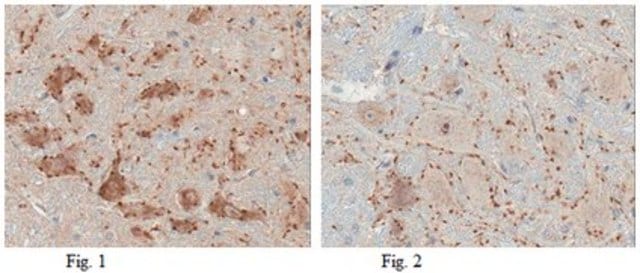C7113
Anti-Calcitonin Gene-Related Peptide antibody, Mouse monoclonal
clone 4901, purified from hybridoma cell culture
Sinónimos:
Anti-CALC, Anti-CCALCI, Anti-CGRP-I
About This Item
Productos recomendados
biological source
mouse
Quality Level
conjugate
unconjugated
antibody form
purified from hybridoma cell culture
antibody product type
primary antibodies
clone
4901, monoclonal
form
buffered aqueous solution
species reactivity
rat, human, canine
packaging
antibody small pack of 25 μL
concentration
~2 mg/mL
technique(s)
immunocytochemistry: suitable
indirect ELISA: 0.5 μg/mL using rat α-CGRP
neutralization: suitable
radioimmunoassay: suitable
isotype
IgG1
UniProt accession no.
shipped in
dry ice
storage temp.
−20°C
target post-translational modification
unmodified
Gene Information
human ... CALCA(796)
rat ... Calca(24241)
General description
Monoclonal Anti-Calcitonin Gene-Related Peptide (CGRP) recognizes rat α-CGRP. The antibody cross-reacts with human and dog α- and β-CGRP.
Immunogen
Application
Immunofluorescence (1 paper)
Immunohistochemistry (1 paper)
Physical form
Disclaimer
Not finding the right product?
Try our Herramienta de selección de productos.
Optional
Storage Class
10 - Combustible liquids
wgk_germany
WGK 3
flash_point_f
Not applicable
flash_point_c
Not applicable
Certificados de análisis (COA)
Busque Certificados de análisis (COA) introduciendo el número de lote del producto. Los números de lote se encuentran en la etiqueta del producto después de las palabras «Lot» o «Batch»
¿Ya tiene este producto?
Encuentre la documentación para los productos que ha comprado recientemente en la Biblioteca de documentos.
Nuestro equipo de científicos tiene experiencia en todas las áreas de investigación: Ciencias de la vida, Ciencia de los materiales, Síntesis química, Cromatografía, Analítica y muchas otras.
Póngase en contacto con el Servicio técnico








